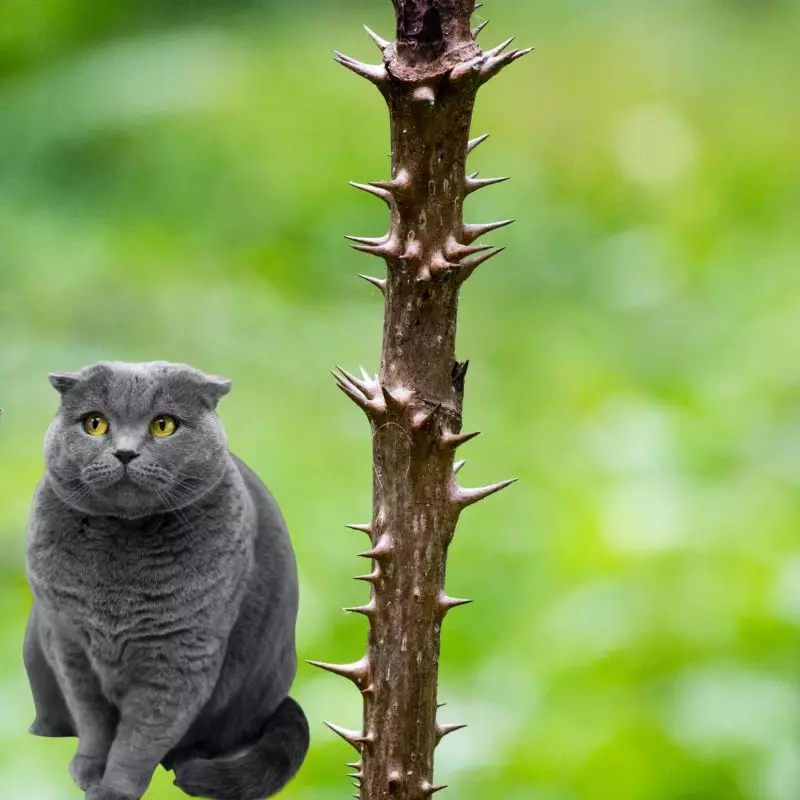Yes, the Angelica tree, also known by its other common names such as Devil’s Walkingstick, Toothache Tree, Hercules’ Club, Prickly Ash, and Prickly Elder, is toxic to cats. Any part of the tree, when consumed, can be harmful. Araliin is the primary toxin found in Angelica trees that can irritate a cat’s gastrointestinal tract, skin, and oral cavity if consumed.
This article was meticulously crafted in collaboration with a team of experienced DVMs (doctors of veterinary medicine). With their invaluable insights and expertise, we aim to provide readers with accurate and up-to-date information regarding the potential risks various plants, in this case, the Angelica Tree, pose to cats. Additionally, to ensure the most reliable information, our research also incorporates insights from high-authority websites such as the ASPCA and PetMD on every plant we discuss.
Clinical Signs of Angelica Tree or Devil’s Walkingstick Poisoning in Cats

When a cat interacts with, smells, or consumes any part of the Angelica tree, various clinical symptoms can manifest, depending on the type and intensity of the exposure. Understanding the cause of each symptom can provide insight into the tree’s effects on cats:
- Drooling Excessively: The presence of Araliin, the primary toxin in the Angelica tree, can irritate the cat’s oral cavity upon direct contact. If a cat chews or tastes the plant, they may start drooling excessively as a reflex to the irritant and an attempt to cleanse the oral cavity of the toxin.
- Vomiting: After ingestion, the toxins in the Angelica tree can irritate the cat’s gastrointestinal tract. Vomiting serves as a defensive mechanism where the body tries to expel the harmful substances ingested.
- Diarrhea: Similar to vomiting, diarrhea is the body’s way of eliminating harmful compounds. The ingestion of the tree’s parts can upset the cat’s digestive system, leading to loose or watery stools.
- Irritation of the Skin or the Interior of the Mouth: Direct contact with the plant can result in topical irritation. Araliin, when it comes in contact with the cat’s skin or the interior of the mouth, can cause redness, swelling, or itchiness.
If your cat exhibits any of these signs after coming into contact with the Angelica tree or Devil’s Walkingstick, it’s crucial to consult a veterinarian immediately.
First Aid and Treatment of Angelica Tree or Devil’s Walkingstick Poisoning in Cats

If your cat shows symptoms of angelica tree poisoning, take him or her immediately to a veterinarian for prompt medical attention.
Discuss your cat’s symptoms with the veterinarian; it would be helpful if you could bring a sample of your cat’s vomit to the veterinarian for testing to discover the cause of the symptoms. Giving the vet information about your cat’s activities, such as spending time outside, can help the vet determine if your cat has been exposed to hazardous substances outside your home.
The vet will provide treatment depending on the severity of your cat’s symptoms. In some very mild cases, treatment will no longer be required. However, for moderate to severe conditions, the vet may induce vomiting, perform gastric lavage, and administer medication to soothe the cat’s stomach.
Recovery from Angelica Tree or Devil’s Walkingstick Poisoning in Cats

In most cases, cats fully recovers from angelica tree poisoning in a day or two. There would be some cases wherein the vet will ask you to leave the cat in his care for a couple of days to be able to monitor your cat’s condition closely. Changes in food intake of your cat may also be advised by the vet. Soft foods and fluid intake is essential to swiftly regain your cat’s health.
Prevention of Angelica Tree or Devil’s Walkingstick Poisoning in Cats
The only ways to prevent angelica tree poisoning in your cats is to avoid areas with angelica trees and to look out for your cats and ensure they are safe inside and outside your homes. Preventing your cats to go outside will minimize the risk of exposure to toxic plants like the angelica trees.
If you love plants but have cats at home, check out these lists:





